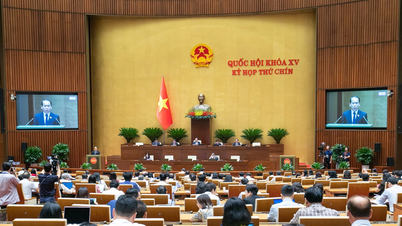The special feature of this chip is the use of new materials that completely replace silicon (Illustration: FS).
Recently, Peking University announced the development of a revolutionary chip, which is said to be 40% more powerful and more energy efficient than today's most advanced processors, without using silicon.
The effort comes as US sanctions aimed at limiting China's access to advanced chip technology appear to have fallen short of their intended purpose.
It's similar to how the Android ban spurred the creation of HarmonyOS (Huawei's self-developed operating system), and now China has been pushing for chip autonomy.
The country even plans to ban the use of Intel and AMD processors in government computers and servers, while also making efforts to produce high-performance chips for artificial intelligence to compete with the world's leading chipset technology group, Nvidia.
With this new step, China not only solves the problem of dependence but can also revolutionize the computer industry with a completely new processing technology. For the first time, a two-dimensional (2D) transistor architecture with a completely silicon-free chip has been successfully developed by Peking University.
According to the development team, the new chip has the potential to become one of the most powerful, efficient, and energy-efficient chips in the world. While traditional silicon chips are gradually reaching physical limits at a size of a few nanometers, China's two-dimensional transistor technology has overcome these barriers.
The chip's unique feature is the use of new materials that completely replace silicon. Specifically, the team used bismuth oxyselenide (Bi 2 O 2 Se) for the channel and bismuth selenite oxide (Bi 2 SeO 5 ) for the gate electrode. These materials form two-dimensional (2D) semiconductors - atomically thin sheets with superior electronic properties.
Advantages of these materials include:
Bismuth oxyselenide (Bi 2 O 2 Se): Possesses high electron transport rates, even without the need for thinness like silicon, and is able to maintain and control charge energy more efficiently.
The transistor's switching of states happens faster, reducing the risk of overheating and minimizing energy loss. According to one researcher, electrons move with almost no resistance, like water flowing through a smooth pipe.
The interface between the two materials is smoother, which helps reduce defects and electrical noise. Architecturally, the new transistor uses a gate-all-around field-effect transistor (GAAFET) structure.
GAAFET technology is not entirely new and has been used for silicon chips below 5 nanometers. However, instead of the traditional vertical FinFET channel structure, the channels in this new design are positioned horizontally.
The team claims the new chip can operate 40% faster and be 10% more energy efficient than today's most advanced 3-nanometer silicon chip architectures.
Although this is a lab-scale achievement, the team has successfully integrated the chip into prototype devices, demonstrating compatibility with existing electronic circuits. This opens up the prospect of mass production, and the researchers are optimistic about working on the manufacturing process on an industrial scale.
While commercialization may take several years, the innovation represents China's aggressive effort to reduce its dependence on US technology and potentially overcome the limitations of traditional silicon technology, opening a new chapter in computing history.
Source: https://dantri.com.vn/cong-nghe/trung-quoc-tren-da-cach-mang-cong-nghe-voi-chip-khong-dung-silicon-20250517113350547.htm






![[Photo series] Admire the skylight glass roof gradually taking shape at the 35 trillion VND terminal of Long Thanh Airport](https://vphoto.vietnam.vn/thumb/1200x675/vietnam/resource/IMAGE/2025/8/16/851fc79edc1e4b1ab9e51763f85ede9a)



![[Photo] General Secretary attends the inauguration ceremony of the Ministry of Public Security Headquarters](https://vphoto.vietnam.vn/thumb/1200x675/vietnam/resource/IMAGE/2025/8/16/3ceec3a24ef945c18ae2b523563b749d)












![[Photo] National Assembly Chairman Tran Thanh Man attends the inauguration ceremony of President Ton Duc Thang Memorial House](https://vphoto.vietnam.vn/thumb/1200x675/vietnam/resource/IMAGE/2025/8/16/23555950872d428a8708a1e2f94cbf59)
![[Photo] Prime Minister Pham Minh Chinh attends a special art program called "Hanoi - From the historic autumn of 1945"](https://vphoto.vietnam.vn/thumb/1200x675/vietnam/resource/IMAGE/2025/8/15/c1c42655275c40d1be461fee0fd132f3)



![[Photo] Red and yellow stars at the launching ceremony of the program "Moving Forward with Vietnam"](https://vphoto.vietnam.vn/thumb/1200x675/vietnam/resource/IMAGE/2025/8/16/076df6ed0eb345cfa3d1cd1d7591a66f)

![[Photo] “Moving forward with Vietnam” on the most romantic road in Vietnam](https://vphoto.vietnam.vn/thumb/1200x675/vietnam/resource/IMAGE/2025/8/16/0ee500bc59fd4468863261ee26f47fe7)
![[Photo] Prime Minister Pham Minh Chinh talks on the phone with Cambodian Prime Minister Hun Manet](https://vphoto.vietnam.vn/thumb/1200x675/vietnam/resource/IMAGE/2025/8/15/72d3838db8154bafabdadc0a5165677f)



































































Comment (0)